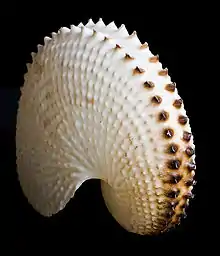Argonautidae
The Argonautidae are a family of pelagic cephalopods that inhabit tropical and temperate oceans of the world. The family encompasses the modern paper nautiluses of the genus Argonauta along with several extinct genera of shelled octopods. Though argonauts are derived from benthic octopuses, they have evolved to depart the sea floor and live their life-cycle in the open seas.[1]
| Argonautidae Temporal range: Oligocene – Recent | |
|---|---|
 | |
| Eggcase of Argonauta nodosa, showing the derived double keel of the genus | |
| Scientific classification | |
| Kingdom: | Animalia |
| Phylum: | Mollusca |
| Class: | Cephalopoda |
| Order: | Octopoda |
| Superfamily: | Argonautoidea |
| Family: | Argonautidae Cantraine, 1841 |
| Genera | |
The family is characterised by brittle white shells constructed by the females, but which the dwarf male argonauts lack. These shells are primarily egg-cases, and are not attached to the body of the female. Paper nautiluses are often found washed up on beaches and are valued for their delicate beauty. The shell also plays the role of a buoyancy device, which the female controls by varying the amount of gulped air.[2] All eggcases possessing nodes, ribs, and a double keel, with the exception of those of fossil Kapal batavus, have been assigned to Argonauta. Eggcases lacking these morphological features have been placed in the other Argonautidae genera.[3]
Fossil Argonautidae eggcases have been described from Japan, New Zealand, Sumatra, Europe, and California.[3]
References
- Young, R.E., Vecchione, M. & Donovan, D.T. (1998) The evolution of coleoid cephalopods and their present biodiversity and ecology.South African Journal of Marine Science, vol. 20,pp. 393–420.
- Finn, Julian K., and Mark D. Norman. "The Argonaut Shell: Gas-mediated Buoyancy Control in a Pelagic Octopus." Proceedings: Biological Sciences 277, no. 1696 (2010): 2967-971. Accessed March 14, 2020. www.jstor.org/stable/27862405.
- Saul, L.; C. Stadum (2005). "Fossil Argonauts (Mollusca: Cephalopoda: Octopodida) From Late Miocene Siltstones Of The Los Angeles Basin, California". Journal of Paleontology. 79 (3): 520–531. doi:10.1666/0022-3360(2005)079<0520:FAMCOF>2.0.CO;2.
Further reading
- (in German) Bandel, K. & W.-C. Dullo (1984). Zur Schalenstruktur fossiler und rezenter Argonauta-Gehäuse (Octopoda, Cephalopoda). Natur und Mensch: Jahresmitteilungen der Naturhistorischen Gesellschaft Nürnberg 1984: 33–38.
- Kaseno Y (1955). "Neogene Argonautinae from Kahoku-gun, Ishikawa Prefecture, Japan". Kanazawa University, Science Reports. 3: 339–344.
- Kobayashi T (1954). "Izumonauta, a new genus of the Argonautinae, with a note on their rare but gregarious fossil occurrence". Japanese Journal of Geology and Geography. 25 (1–2): 21–34.
- Kobayashi T (1956). "A palaeo-meteorological interpretation to the occurrence of the Argonautinae in Province Kaga, central Japan". Japanese Journal of Geology and Geography. 27 (2–4): 93–104.
- Lewy Z (1996). "Octopods: nude ammonoids that survived the Cretaceous-Tertiary boundary mass extinction". Geology. 24 (7): 627–630. doi:10.1130/0091-7613(1996)024<0627:ONATST>2.3.CO;2.
- Tomida S.; Shiba M.; Nobuhara T. (2006). "First post-Miocene Argonauta from Japan, and its palaeontological significance". Cainozoic Research. 4 (1–2): 19–25.
- Yanagisawa Y (1990). "Age of fossil Argonautidae (Cephalopoda) from Hokuriku Province (central Honshu, Japan) based on diatom biostratigraphy" (PDF). Bulletin of the Geological Survey of Japan (in Japanese). 41 (3): 115–127. Archived from the original (PDF) on 2007-09-27.
- Argonautidae at the Tree of Life Web Project